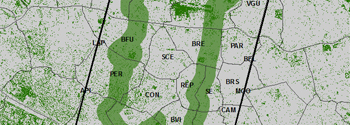CURRENT PANORAMA OF ARBOREAL COVERING AT SÃO PAULO CITY
DOI:
https://doi.org/10.11606/issn.2179-2275.v9i1p29-48Keywords:
Vegetation Index, TVI, Land Use and Occupation, Geographic Information System, Urban ForestAbstract
Green areas in the cities are increasingly being replaced by asphalt and buildings, mainly in downtown regions, causing several problems to the structure of the city and to the preservation of the urban biodiversity. This study aims to quantify the tree covering in São Paulo City, SP, discussing its implications in the urban landscape. It was quantified the arboreal covering of a sample section of São Paulo City, SP, by using images of Worldview 2 satellite and Quantum GIS software, generating the Vegetation Index (TVI) per district. With the TVI, the area and the percentage of vegetation of each district were obtained with Fragstats software. The most wooded areas are Cachoeirinha, Tremembé, Mandaqui, Vila Andrade, and Morumbi; and the less: Limão, Santa Cecilia, Cambuci, Sé and Brás. Only two districts present an ideal percentage of vegetation recommended by specific literature. Arboreal covering seems to be linked to the income level of the region, having the wealthy neighborhoods, in general, a higher percentage of vegetation. An environmental scenario for the study area was presented, aiming to increase the percentage of arboreal covering and the connection to existing vegetation spaces.Downloads
References
ATLAS BRASIL. Ranking São Paulo 2010. Disponível em: http://atlasbrasil.org.br/2013/pt/ranking. Acesso em 21/05/17.
BARÓ, F. et al. Contribution of ecosystem services to air quality and climate change mitigation policies: The case of urban forests in Barcelona, Spain. Ambio, v. 43, n. 4, p. 466–479, 2014.
BEYER, K. M. M.; KALTENBACH, S.; BOGAR, S.; NIETO, F.; MALECKI, K.KM. Exposure to neighborhood green space and mental health: Evidence from the survey of the health of Wisconsin. International Journal of Environmental Research and Public Health, v. 11, n. 3, p. 3453–3472, 2014.
COSTA, J. A. Uso de imagens de alta resolução para definição de corredores verdes na cidade de São Paulo. 2010. 114p. Dissertação (Mestrado) - Escola Superior de Agricultura “Luiz de Queiroz, Universidade de São Paulo, Piracicaba, 2010.
DIGITALGLOBE FUNDATION. Disponível em: http://www.digitalglobefoundation.org/. Acesso em 17 nov. 2016.
FRANCO. Infraestrutura verde para a resiliência urbana às mudanças climáticas da cidade de São Paulo. Relatório Científico de Progresso (R-1 FAPESP/ANUAL). Processo 15/10597-0. Faculdade de Arquitetura Urbanismo e Design da Universidade de São Paulo, 2016.
IBGE. Instituto Brasileiro de Geografia e Estatística. 2010. Disponível em: http://cidades.ibge.gov.br/xtras/perfil.php?codmun=355030. Acesso em: 20. mar. 2017.
KÖPPEN, W. Climatologia: con un estudio de los climas de la tierra. Fondo de Cultura Econômica. México. 1948. 479p.
LEFF, M. The Sustainable Urban Forest: A Step-by-Step Approach. Davey Institute / USDA Forest Service. 2016. 102p.
LI, H.; CHEN, W.; HE, W. Planning of green space ecological network in urban areas: an example of Nanchang, China. International Journal of Environmental Research and Public Health, v. 12, n. 10, p. 12889–12904, out. 2015.
MAHER, B. A. et al. Impact of roadside tree lines on indoor concentrations of traffic-derived particulate matter. Environmental Science and Technology, v. 47, n. 23, p. 13737–13744, 2013.
MCPHERSON, E. Gregory. Accounting for benefits and costs of urban greenspace. Landscape and Urban Planning, v. 22, n. 1, p. 41-51, 1992.
NOBRE C.A.; YOUNG, A.F.; SALDIVA, P.; MARENGO, J.A.; NOBRE, A.D.; ALVES JR., S.; SILVA, G.M.C.; LOMBARDO, M. Vulnerabilidade das Megacidades Brasileiras às Mudanças Climáticas: Região Metropolitana de São Paulo, Relatório Final. Instituto Nacional de Pesquisas Espaciais-INPE, Sumário executivo, p.32, 2010.
NOWAK, D. J.; HIRABAYASHI, S.; GREENFIELD, E. Tree and forest effects on air quality and human health in the United States. Environmental Pollution, v. 193, p. 119–129, 2014.
O ESTADO DE S. PAULO. Vila Andrade, o ‘novo Morumbi’, é o bairro que mais cresce, 2014. Acesso em: 17 jun. 17. Disponível em: http://sao-paulo.estadao.com.br/noticias/geral,vila-andrade-o-novo-morumbi-e-o-bairro-que-mais-cresce,1607979

Downloads
Published
Issue
Section
License
O detentor dos direitos autorais é o autor e eventuais coautores do artigo. A Revista LABVERDE exige apenas o ineditismo na publicação do artigo. O autor tem o direito de divulgar seu artigo conforme sua conveniência devendo citar a revista.
A Revista LABVERDE autoriza a republicação de seus artigos desde que devidamente citada fonte e autoria.


